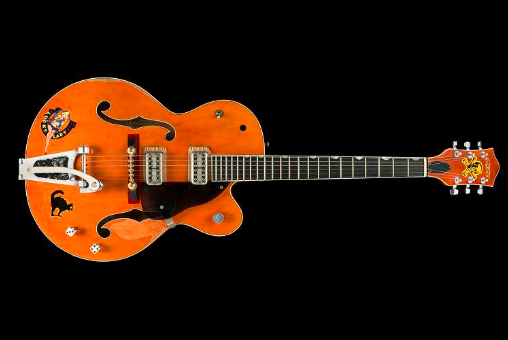Old-Time Rock ‘n’ Roll:
How The 1980s Embraced 1950s and 1960s Oldies Music
The Stray Cats

Photo: Electric Guitar (Gretsch). Gift of Brian Setzer. National Museum of American History.
GUID (Link to Original Record)
http://n2t.net/ark:/65665/ng49ca746b0-e9de-704b-e053-15f76fa0b4fa
The Stray Cats, an early 1980s rockabilly band, became a big hit on radio and MTV. Although they dressed as an eighties punk rock group, they did not sound like one. They sounded like a late 1950s/early 1960s rock ‘n’ roll band. Brian Setzer, the lead singer, played a vintage, hollow body guitar. Lee Rocker played a stand up double bass at a time when many rock bassists played electric. Drummer Slim Jim Phantom played on a small drum set, whereas his counterparts in other popular rock bands hid behind huge drum kits. The band’s influences include Hank Williams, Elvis Presley, Gene Vincent, Eddie Cochran, and Carl Perkins. This Long Island band first hit it big in England, where Europeans have always treasured American blues, before they succeeded in America. Despite having a vintage sound that appealed to baby boomers, the songs rocked and kids danced. Teenage girls found the twenty-something band members cute. Guys liked the punk vibe the Stray Cats, the Blasters, and other early 1980s rockabilly bands possessed without the negative, aggressive punk attitude. Rock This Town
and Stray Cat Strut
made it into the Billboard top ten. Their song Sexy and 17
peaked at number fourteen on the Billboard Hot 100 .
The band broke up in 1984, but has regrouped several times. In the 1990s, Setzer formed the Brian Setzer Orchestra, a swing band. Just as he rode a nostalgia wave for rock ‘n’ roll music in the early 80s, he benefited from the swing music resurgence of the late 1990s/early 2000s. The Orchestra’s remake of Jump Jive Wail
dominated airplay in 1998.